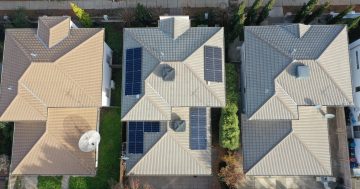
If safe to do so, Canberrans have been advised to turn down heaters and pull on extra layers to conserve energy as the national grid faces immense pressure. Photo: File.
Canberrans have been urged to reduce electricity consumption where possible as the national grid faces increasing pressure.
The ACT Government sent out an alert overnight warning power could be in short supply.
The Territory forms part of the NSW grid, which has been issued a Lack of Reserve level 3 (LOR3) forecast for this evening (16 June).
“At this point in time, the ACT Government is asking ACT residents and businesses to voluntarily reduce their electricity use where possible,” a statement said.
“It is important that we reduce our electricity usage to help ensure that the electricity system continues to function effectively and that mandatory load shedding is avoided.”
The advice came as the Australian Energy Market Operator (AEMO) suspended the wholesale spot market yesterday afternoon (15 June), essentially taking control of power distribution and supply from electricity generators.
It’s the first time the market has been suspended.
AEMO chief executive Damien Westerman warned electricity supplies would remain tight in the coming days, particularly in NSW.
“This is to ensure [household’s] lights go on when they flick the switch,” he said.
Previously AEMO had placed a $300 per megawatt-hour price cap on electricity, which saw some energy generators withdraw from the market rather than sell their product at a loss.
Now AEMO will be in charge of what power will be available and when.
“This decision was made because it has become impossible to continue operating the spot market while ensuring a secure and reliable supply of electricity,” Mr Westerman said.
On Tuesday (14 June), the market operator was forced to direct 5 GW of generation through direct interventions, representing 20 per cent of demand.
“In the current situation, suspending the market is the best way to ensure a reliable supply of electricity for Australian homes and businesses,” Mr Westerman said.
“The situation in recent days has posed challenges to the entire energy industry and suspending the market would simplify operations during the significant outages across the energy supply chain.”
Compensation would be offered to energy generators to recoup their losses.
“It is not true to say prices will go up [for customers] under this market suspension,” Mr Westerman said.
The Australian Energy Council said it understood the need to suspend the market in order to “reset it”.
“It is quite clear that in these unprecedented circumstances and following the application of the Administered Price Cap, the power system was becoming unmanageable,” chief executive Sarah McNamara said.
“We hope the conditions improve in this new phase and we can soon return to an uncapped market.”
The market suspension is being reviewed daily.
ACT Energy Minister Shane Rattenbury said he supported the actions of the market regulator.
“The system was clearly at a breaking point and their decision to suspend the market has provided improved reliability in the short-term,” he said.
“We have seen an extraordinary set of circumstances that clearly point to the fact that we need to revaluate how the energy market is operating. It clearly is not fit for purpose and some of the conduct we have seen from the generators in the last week or so is unacceptable.
“Energy Ministers across Australia will need to look at this very closely and look at what changes need to be made to the rules.”
The Environment, Planning, and Sustainable Development Directorate has advised Canberrans to reduce power consumption.
“The public can assist in reducing demand on the electricity network by turning off unnecessary lighting and electrical appliances,” it said.
“If it is safe for you to do so, only turn the heater on for rooms you are using, set the temperature to around 20 degrees, and close windows, doors and blinds to help keep the heat in.
“The ACT Government is continuing to work with the energy market bodies to find a resolution for the issues currently affecting the electricity market. We hope the ACT public will understand the current challenges and do what they can to reduce electricity use.”
In the most extreme scenario, Canberrans may be directed by AEMO to immediately begin supply interruptions, known as ’emergency load shedding’.
“We are hoping to avoid unexpected interruptions to our electricity supply, and a reduction in electricity use by customers will help to reduce this risk.”
To reduce energy usage, Evoenergy recommends consumers:
- Turn off unnecessary lights
- Reduce use of heating (set temperature to 20°C or lower)
- Minimise use of cooking equipment
- Consolidate refrigeration and turn off unnecessary fridges
- Reduce use of dishwashers, clothes dryers, vacuum cleaners and second televisions
- Reduce use of pool pumping and heating operation
- Reduce the use of TVs or computers for game purposes.





















